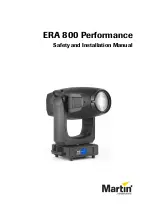
4-11
2000-OSM, F1
•
Vista Basic commands identify the detector by placing the Chroma I/O Board number after the
alarm name (e.g., CUR_STRM (1) or INTEGER = RAI (1,0), where the first digit identifies the
Chroma I/O Board).
Before starting an analysis, the GCC prompts for the Chroma I/O Board to use during the analysis.
The selected Chroma I/O Board must be in Master mode or the analysis will not start. If the second
Chroma I/O Board is running as Slave and it is linked to the Master board, an analysis will start on it
as well. If both boards are in Master mode, the analyses can be synchronized by pressing the F4
(Start on Both Masters) soft key. This scheme works only if the cycle times are the same length for
the methods used.
CIRCUIT BOARDS
Power Supply PCB
The Power Supply PCB, on the left side wall of the GCC Card Cage, converts the system input power
to provide voltages for the other boards and functions in the analyzer. Its outputs i5 Vdc for
digital circuits, +15 Vdc and -15 Vdc for analog circuits, and 18 Vac for current modules on the Analog
Output PCB. The Power Supply PCB also has alarm LEDs to assist in isolating power problems.
Chroma I/O PCB
The Chroma I/O PCB, in GCC Card Cage slot 2, uses the control information from the SBC to switch
valve and recorder output functions. During an analysis, the Chroma I/O Board processes detector
amplifier output to provide digital and analog outputs for post analysis verification. When a second
Chroma I/O PCB is used it is in GCC Card Cage slot 1.
Single Board Computer (SBC) PCB
The Single Board Computer PCB, in GCC Card Cage slot 3, provides all analyzer system control
functions. On the SBC reside E
2
PROM storage, computer memory, and the address and data control
circuits which coordinate internal and external data activities.
DC Solenoid Driver PCB
The DC Solenoid Driver PCB, at the bottom left of the GCC Card Cage, has ten solenoid control
circuits. It generates a +110 volt signal for energizing the solenoids controlling the analyzer and
sample system valves. When the controlling signal (common) from the control section is applied to
any of the inputs, a transistor completes the circuit to the appropriate solenoid. If a second DC
Solenoid Driver PCB is used, it is at the bottom right of the GCC Card Cage.
Front Panel PCB
The Front Panel PCB, on the inside of the GCC front panel, provides the interface for the display, the
intrinsically safe recorder jacks, and the keypad. This assembly is also the platform for the optional
LO COMM PCB.
FID Amplifier PCB
The FID Amplifier PCB, on the left side wall of the GCC, amplifies the flame ionization detector output
signal and applies it to the Chroma I/O Board for processing. This assembly also accomplishes FID
flame sensing and ignition. This PCB's gain configuration is set at the factory.
















































